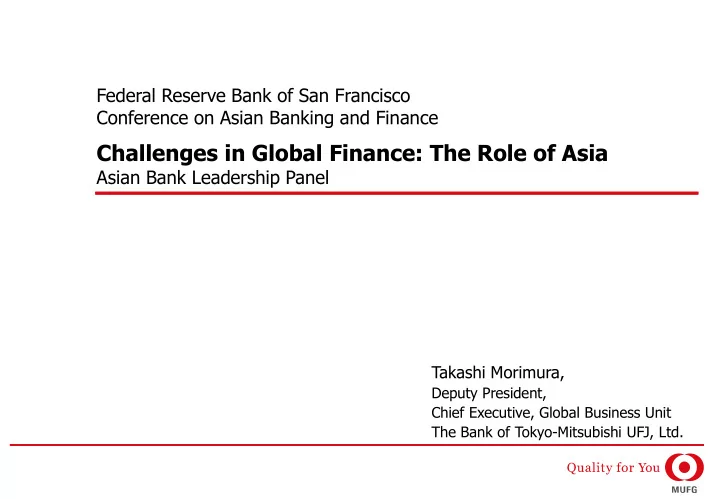

Federal Reserve Bank of San Francisco Conference on Asian Banking and Finance Challenges in Global Finance: The Role of Asia Asian Bank Leadership Panel Takashi Morimura, Deputy President, Chief Executive, Global Business Unit The Bank of Tokyo-Mitsubishi UFJ, Ltd.
Today ’ s Agenda I. Overview of the Asian Market (1) Asian market from the viewpoint of Japanese financial history (2) Future growth based on expected demographic shifts II. Growth of Asian Countries (1) Evolution of economies after the Asian currency crisis (2) Impact of the European economic crisis on the Asian market III. BTMU ’ s Strategic Initiatives in Asia (1) Promotion of foreign capital investment in Asia (2) Financing for Asian growth Infrastructure Facility investment Trade finance (3) Further development of Asian financial markets Markets/Regulations Human resources 1
Asian Market from the Viewpoint of Japanese Financial History Asia consists of various countries which vary in economic fundamentals, regulations, and financial development. It is essential to consider the stage each country is at for developing strategies and business plans. History of Japanese banks, GDP growth rate, and GDP per capital (2010) Demographic Bonus Demographic Onus "Oil High growth Stable growth Bubble Low growth Shock" Growth stage: globalization Development stage: banking business with a focus on loan / deposit Expansion stage: expansion of product lineup Maturity stage: enhancement of global business Full revision of Foreign Exchange and Foreign Trade Control Law GDP GDP Lifting of ban on mutual entry into bank, trust bank, and securities per capita growth Report released by Japan-US Yen-Dollar Committee Deregulation of domestic investments from foreign investors (USD) rate Singapore Lifting ban on financial holding companies Plaza Accord Liberalization of overseas capital transactions Full liberalization of deposit interest rate Big Bang Full liberalization of foreign exchange 20% 40,000 Hong Kong 15% 30,000 Opening of Tomei and Meishin Expressway Financial System Reform Act 10% Korea Osaka Expo 20,000 : GDP per capita Taiwa : GDP growth rate n Tokyo Olympics 5% China's coastal areas* Malaysia 10,000 0% China (avg.) Thailand Cambodia Philippines Vietnam Myanmar Indonesia 0 India -5% インド 1960 1961 1962 1963 1964 1965 1966 1967 1968 1969 1970 1971 1972 1973 1974 1975 1976 1977 1978 1979 1980 1981 1982 1983 1984 1985 1986 1987 1988 1989 1990 1991 1992 1993 1994 1995 1996 1997 1998 1999 2000 2001 2002 2003 2004 2005 2006 2007 2008 2009 2010 <$3k $3k< <$10k $10k< $30k< (National Bureau of Statistics of China) *Shanghai in 2009 2 (Source: IMF and Cabinet Office)
Economic Growth of Asian Countries The fragile position at the time of Asian financial crisis has improved. The higher resistance to an economic crisis allows major Asian countries to cope with the economic crisis, if any. Current Account and Foreign Exchange Reserve Transition of Major Asian Countries Nominal GDP Current Account Foreign Debt Foreign Exchange Reserve FY1997 FY2010 FY1997 FY2010 FY1997 FY2010 FY1997 FY2010 GDP Amount ( US$Bn ) % of Nominal GDP % of Nominal GDP Import (months) China 953 5,878 3.9% 5.2% 13.9% 6.3% 11.8 24.5 Korea 532 1,014 -1.8% 2.8% 33.7% 28.8% 1.7 8.2 Taiwan 299 430 2.3% 9.4% 11.2% 20.5% 8.7 18.2 Indonesia 238 707 -2.3% 0.9% 63.2% 17.2% 5.0 8.5 Malaysia 102 238 -5.7% 11.8% 47.1% 28.6% 3.3 8.6 Thailand 151 319 -2.0% 4.6% 72.7% 15.8% 5.3 12.8 Philippines 93 200 -4.8% 4.5% 17.4% 38.5% 2.7 13.6 India 421 1,632 -1.4% -3.2% 24.2% 19.0% 8.0 10.5 Vietnam 27 104 -5.7% -3.8% 80.8% 34.0% 2.7 1.8 3
BTMU ’ s Strategic Initiatives in Asia Finance from private banks is essential for infrastructure development considering the $700Bn gap between infrastructure needs and public finance/private investment in Asia. BTMU focuses on financing for infrastructure projects in Asia. BTMU focuses on financing of Japanese corporations for facility investment and trade finance to meet increasing expansion and investment in Asia Infrastructure needs forecast in Asia Direct investment No. of Japanese companies’ subsidiaries from Japan to Asia ( 2010~20 )( US$Bn ) ( JPY 100Mil ) New Renewal Demand Total FY1991 FY2010 FY1991 FY2010 Power 3,176 912 4,089 Asia Total 3,156 11,497 8,107 21,254 Communication 325 730 1,056 Transportation 1,762 705 2,466 China 184 4,619 787 7,463 1,702 638 2,341 Road Port 50 25 76 Hong Kong 476 946 1,260 1,604 Railroad 3 36 39 Taiwan 463 751 554 176 Airport 7 5 11 Water 155 226 381 Korea 245 581 357 1,260 Total 5,419 2,573 7,997 Singapore 509 830 837 3,232 Infrastructure 11 years total : $8 Tn Needs Annual : $730 Bn Thailand 488 1,434 1,107 1,839 Philippines 125 392 277 552 $700Bn gap annually Public Finance/ Malaysia 366 616 1,202 1,261 Total : $27 Bn annually Private Public Finance : $7 Bn annually Investment in Indonesia 215 585 1,628 959 Private Investment : $20 Bn annually Infrastructure ( Source ): METI ”survey of overseas business activity” MOF/BOJ ”Outward/Inward Direct Investment” 4
Recommend
More recommend